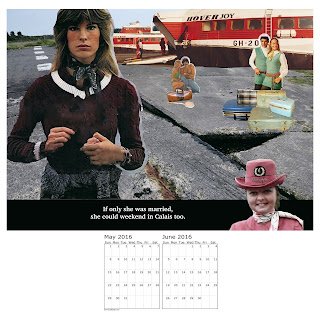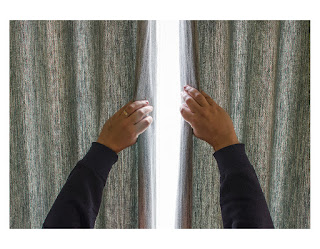9th August:
For my first level 3 assignment I need to make around 30 images and reflect on how my work takes inspiration or relates to a particular genre. "Don't spend too much time considering what you'll do - get started as soon as possible".
I have a couple of ideas that I want to explore for the duration of this course. Which one to choose first is the question. In the end I went online and did some brief research and this fired my imagination enough for me to want to start making props for one of them. This is always a good sign for me - to have a couple of strong visual images to get me going that will hopefully lead to a body of work.
So the idea that I am going to tentatively pursue is based on the abuse and murder of Gay men in Nazi concentration camps during WWII. There is very little history written about this minority group as at the time Homosexuality was illegal in most of Europe and their issues and treatment was considered inconsequential. Much of the information is anecdotal and has not been recorded - except in journals and autobiographies published decades after these events took place.
This assignment is an exercise designed to get started and to practice creative play skills without worrying too much about where the project may lead. So I'm not delving too deep into the research at this early stage. I have a couple of strong visual images in my head that I want to make. These relate to the murder of a young Gay man in a camp who was stripped naked, had a bucket placed over his head, and was then mauled to death by the guard's German Shepherd dogs. Grim stuff...
I ordered one of the most famous autobiographies second hand through Amazon and will use this as source material for image ideas. But also, I don't just want to make literal representations; I want to conceptualise this information and incorporate it into the wider aspect of Identity and reference how representation by the majority can strip minority identity and enforce a negative 'Other' identity in its place.
It's early days yet though. I'm just going to order props, make work, and see where it takes me...
11th August:
The bucket's arrived. Time to get bashing! I couldn't wait to make my first shot so when the bucket was sufficiently dented I did a test shoot on my partner against a blank piece of wall.
I really like this image. I have in mind a friend who is much closer in age to the young man I read about. Hopefully he will be prepared to model some of the props for me. But I've made my first photograph and it feels good to pick up my camera.
12th August:
I've accumulated a tub of barbed wire, some pink fabric to make pink triangles and some striped material to make a scrap of prison uniform. I'm sure most people are aware of the triangle categorisation used to identify concentration prisoners.
"Originally intended as a badge of shame, the pink triangle (often inverted from its Nazi usage) has been reclaimed as an international symbol of Gay pride and the Gay rights movement, and is second in popularity only to the rainbow flag.
Every prisoner had to wear a downward-pointing triangle on their jacket, the colour of which was to categorise them by 'kind'. Other colours identified Jewish people (two triangles superimposed as a yellow star), political prisoners, Jehovah's Witnesses, 'anti-social' prisoners, and others the Nazis deemed undesirable. Pink and yellow triangles could be combined if a prisoner was deemed to be Gay and Jewish."
13th August:
I've fashioned a barbed wire necklace to use as a prop. This image uses metaphor to connote suffering as one possible meaning rather than any literal translation of something I've read.
17th August:
My model, Rik has come over and we've improvised some shots against a tiled backdrop that I've concocted from a roll of wallpaper, a piece of hardboard, and some clips. The shoot was a great success in as much as Rik was a very willing participant in my craziness. I'd also made some props from the barbed wire, got hold of some fake theatrical blood and some fresh flowers. Apart from the bucket allusion to a historical event, for the rest of the shoot I went with a free-flow of thoughts and ideas to see where they would take me. I felt a bit nervous doing this. I am usually fairly meticulous with my planning.
18th August:
I've made some more images. Apart from the bucket shot I'm not sure about the others. They are very literal interpretations mostly. I need to keep reminding myself that these are not the final images. They are a starting point. There is a part two to this idea which I haven't detailed here yet. I'm at that point when self doubt is creeping in and I have to hold out rather than make any knee jerk decisions about the work. Where am I going with all this?
One shot that I do like is of a briefcase I took down to Folkestone and flung against a wall. In order for the Nazis to begin to strip away a person's humanity, various new societal restrictions needed to take place. The loss of freedoms, unable to do certain jobs, travel to certain places in a city, and curfews are all a part of the process that led to the concentration camps.
This shot refers to medical experiments to 'cure' the Gayness. It doesn't quite work. I have an idea for another shot and will redo this one at some point.
I made my scrap of prisoner uniform and tried some shots against a fence. No pun intended!
I can't say that I really like them that much. I'm at the stage were I need to think about sending what I have to my tutor, detailing my concerns and hoping I eventually find a way to move forward. I'm still undecided.
On our way out for coffee I was discussing the problem of the literalness of the photographs with Gerry; how I need to be more conceptual in my thinking. My critical ideas around identity that have brought me to this point in the course needs to be more incorporated into the work somehow. I'm not making work about Nazi concentration camp victims alone. It is more than that.
This is where I point out that these images are only intended to form the first part of my project. I want to take my photographs and conceptualise them in some way. I've just recently returned from an extended trip around California, Oregon and Washington State in America. Because we are both creative types, my partner Gerry and myself wanted to do an art project as part of our travels
We conceived of the idea of making small structures in the landscape using whatever natural materials might be to hand. We decided to call them 'Citadels' as a sort of reference to a Gay couple living in a world that is mainly aligned to the Heterosexual majority - and how that affects our rights and freedoms. I usually refer to this model as the 'Heterosexual Binary Gender Matrix'.
Here are some of the images we made along the way:
The last image is particularly special to me as it was made to memorialise the Orlando 49 who were murdered in Florida while we were on our trip.
What I wanted to do was to incorporate my photographs into new structures, a bit like the Citadels. I would fold the photographs that I've made and sew them into pink cloth triangles. These would be incorporated into structures and placed in reflective spaces, like woodland or alongside streams etc.
My thinking on this is not totally clear at the moment. I can't help but feel this is all a bit cobbled together and tenuous to say the least. But what is it that the assessment says about risk taking? I always score highly for taking risks that have successful outcomes. Maybe I should stick with it for now...
August 19th:
I know I have the skills to make something of this work if I wanted to. Is it because I am not fully committed to the initial idea? Is it a grain of an idea that has run out of steam early on in the process? Having the confidence to know when to toss an idea into the bin and start again is also something I have learnt to do on this degree pathway.
Either way, I will send what I have to my tutor for advice and document my concerns along with it.
August 20th:
Okay. A complete and utter turnaround has occurred. I doggedly pursued my concept and printed out my images onto A4 photo paper and began experimenting with folding them into triangles. This was initially to show my tutor how the images would be sewn into the pink cloth triangles for the new 'Citadel' type structures. My notes would explain how little enthusiasm I had for the project...
As soon as parts of my images began to fragment I could see that I had something! The literalness of the images dissolved into something much more interesting! They became fragmented parts of the narrative of violence and dehumanisation that I was alluding to! I did not need to sew them into cloth triangles and make new 'Citadel' structures. I had something right here with these paper triangles.
I spent the rest of the day experimenting and getting inky black fingers from paper folding.
These are the preliminary shots I'm sending to my tutor for assignment 1. I'm feeling very pleased with what I have so far and now it is definitely time to send them off and await tutor feedback.
October 30th:
I had a Skype session with my tutor Keith Roberts. I'm still not sure how I feel about video sessions as I am so used to dealing with the written report and reflecting on it. This isn't a criticism. It just takes me a long time to get used to changes like this. Luckily my tutor also summarised the session and supplied in written form the references and links that we spoke about. The feedback was positive and the references will be very useful. I will particularly find useful a PHD thesis that references art's response to the homosexual concentration camp experiences - rather a surprise to be know that this work has been written about. There really is nothing new in art. With this and the other references I will be combing through them all in the next couple of weeks before I begin my next assignment and I will make separate posts for each one that I will link to here:
The question was raised on the literalness of the triangle shape. Do I need to think of different ways in which to progress this work? I'm quite stuck on the physical shape of the triangle. It is such an iconic emblem of Gay politics. We spoke about using two images with the viewer making up the final part of the triangle. This is an interesting idea that I might try to explore for the next assignment.
I feel that I'm progressing through the two courses, although it does take some getting used to switching between the assignments on the different modules.
Suggested
reading/viewing
As
discussed …. Go back to Jenkins’ ‘Re-Thinking History’ text …
perhaps in specific relationship to bias (Page 44)
In
addition to this you might want to get copies of the following:
Hirsch, M.
2012.Family Frames:Photography, Narrative and Postmemory. Cambridge.
(Mass). Harvard University Press
Edwards,
E. and Morton, C. (2015).
Photographs, Museums, Collections : Between Art and Information.
London. Bloomsbury Publishing Plc









































